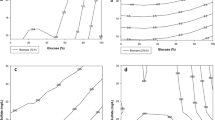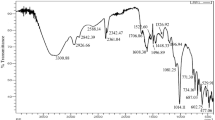Abstract
In this study, the major factors affecting both cell growth and astaxanthin production of Chlorella zofingiensis under dark were identified and optimized through statistical methods. A Plackett-Burman design was initially used to evaluate seven culture factors, of which glucose, NaNO3, and MgSO4·7H2O were found to be the most important in affecting C. zofingiensis. The central composite design and response surface methodology (RSM) were further used to optimize these factors. The optimized glucose, NaNO3, and MgSO4·7H2O concentrations for cell growth were 46.7, 1.13, and 0.125 g/L MgSO4·7H2O respectively, and for astaxanthin production were 35.2, 0.281, and 0.023 g/L, respectively. After the optimization, a two-stage culture strategy was employed to further maximize astaxanthin production, and the results showed that the astaxanthin yield of C. zofingiensis could reach 15.1 mg/L, which was 74% higher than that achieved in batch culture using the basal medium (i.e., 8.7 mg/L).
Similar content being viewed by others
References
Lorenz RT, Cysewski GR. Commercial potential for Haematococcus microalgae as a natural source of astaxanthin. Trends Biotechnol. 18: 160–167 (2000)
Higuera-Ciapara I, Felix-Valenzuela L, Goycoolea FM. Astaxanthin: A review of its chemistry and applications. Crit. Rev. Food Sci. 46: 185–196 (2006)
Guerin M, Huntley ME, Olaizola M. Haematococcus astaxanthin: Applications for human health and nutrition. Trends Biotechnol. 21: 210–216 (2003)
Hussein G, Sankawa U, Goto H, Matsumoto K, Watanabe H. Astaxanthin, a carotenoid with potential in human health and nutrition. J. Nat. Prod. 69: 443–449 (2006)
Boussiba S, Vonshak A. Astaxanthin accumulation in the green alga Haematococcus pluvialis. Plant Cell Physiol. 32: 1077–1082 (1991)
Boussiba S. Carotenogenesis in the green alga Haematococcus pluvialis: Cellular physiology and stress response. Physiol. Plant. 108: 111–117 (2000)
Sarada R, Tripathi U, Ravishankar GA. Influence of stress on astaxanthin production in Haematococcus pluvialis grown under different culture conditions. Process Biochem. 37: 623–627 (2002)
Harker M, Tsavalos AJ, Young AJ. Autotrophic growth and carotenoid production of Haematococcus pluvialis in a 30 liter airlift photobioreactor. J. Ferment. Bioeng. 82: 113–118 (1996a)
Borowitzka MA. Commercial production of microalgae: ponds, tanks, tubes and fermenters. J. Biotechnol. 70: 313–321 (1999)
Chen F. High cell density culture of microalgae in heterotrophic growth. Trends Biotechnol. 14: 421–426 (1996)
Shi XM, Zhang XW, Chen F. Heterotrophic production of biomass and lutein by Chlorella protothecoides on various nitrogen sources. Enzyme Microb. Tech. 27: 312–318 (2000)
Hata N, Ogbonnal JC, Hasegawa Y, Taroda H, Tanaka H. Production of astaxanthin by Haematococcus pluvialis in a sequential heterotrophic-photoautotrophic culture. J. Appl. Phycol. 13: 395–402 (2001)
Del Campo JA, Rodriguez H, Moreno J, Vargas MA, Rivas J, Guerrero MG. Accumulation of astaxanthin and lutein in Chlorella zofingiensis (Chlorophyta). Appl. Microbiol. Biot. 64: 848–854 (2004)
Ip PF, Wong KH, Chen F. Enhanced production of astaxanthin by the green microalga Chlorella zofingiensis in mixotrophic culture. Process Biochem. 39: 1761–1766 (2004)
Ip PF, Chen F. Production of astaxanthin by the green microalga Chlorella zofingiensis in the dark. Process Biochem. 40: 733–738 (2005)
Cui FJ, Li Y, Xu ZH, Xu HY, Sun K, Tao WY. Optimization of the medium composition for production of mycelial biomass and exopolymer by Grifola frondosa GF9801 using response surface methodology. Bioresour. Technol. 97: 1209–1216 (2006)
Gong XD, Chen F. Influence of medium components on astaxanthin content and production of Haematococcus pluvialis. Process Biochem. 33: 385–391 (1998)
Ramírez J, Gutierrez H, Gschaedler A. Optimization of astaxanthin production by Phaffia rhodozyma through factorial design and response surface methodology. J. Biotechnol. 88: 259–268 (2001)
Kim JH, Kang SW, Kim SW, Chang HI. High-level production of astaxanthin by Xanthophyllomyces dendrorhous mutant JH1 using statistical experimental designs. Biosci. Biotech. Bioch. 9: 1743–1748 (2005)
Liu YS, Wu JY. Optimization of cell growth and carotenoid production of Xanthophyllomyces dendrorhous through statistical experiment design. Biochem. Eng. J. 36: 182–189 (2007)
Miller GL. Use of dinitrosalicylic acid reagent for determination of reducing sugar. Anal. Chem. 31: 426–429 (1959)
Baroli I, Do AD, Yamane T, Niyogi KK. Zeaxanthin accumulation in the absence of a functional xanthophyll cycle protects Chlamydomonas reinhardtii from photooxidative stress. Plant Cell. 15: 992–1008 (2003)
Darley WM. Phytoplankton: Environmental factors affecting growth. pp. 21–52. In: Algal Biology: A Physiological Approach. Wilkinson JF (ed). Blackwell Scientific Publications, London, UK (1982)
Harker M, Tsavalos AJ, Young AJ. Factors responsible for astaxanthin formation in the Chlorophyte Haematococcus pluvialis. Bioresour. Technol. 55: 207–214 (1996b)
Evans HJ, Sorger GJ. Role of mineral elements with emphasis on the univalent cations. Annu. Rev. Plant Physiol. 17: 47–76 (1966)
Lu YK, Chen YR, Yang CM. Influence of Fe-deficiency and Mgdeficiency on the thylakoid membranes of a chlorophyll-deficient Ch5 mutant of Arabidopsis-Thaliana. Bot. Bull. Acad. Sinica. 36: 175–179 (1995)
Fa’bregas J, Domý’nguez A, Alvarez DG, Lamela T, Otero A. Induction of astaxanthin accumulation by nitrogen and magnesium deficiencies in Haematococcus pluvialis. Biotechnol. Lett. 20: 623–626 (1998)
Zhang DH, Lee YK. Two-step process for ketocarotenoid production by a green alga, Chlorococcum sp strain MA-1. Appl. Microbiol. Biot. 55: 537–540 (2001)
Fábregas J, Otero A, Maseda A, Domínguez A. Two-stage cultures for the production of Astaxanthin from Haematococcus pluvialis. J. Biotechnol. 89: 65–71 (2001)
Aflalo C, Meshulam Y, Zarka A, Boussiba S. On the relative efficiency of two-vs. one-stage production of astaxanthin by the green alga Haematococcus pluvialis. Biotechnol. Bioeng. 98: 300–305 (2007)
Author information
Authors and Affiliations
Corresponding author
Rights and permissions
About this article
Cite this article
Chen, T., Wang, Y. Optimized astaxanthin production in Chlorella zofingiensis under dark condition by response surface methodology. Food Sci Biotechnol 22, 1–8 (2013). https://doi.org/10.1007/s10068-013-0221-7
Received:
Revised:
Accepted:
Published:
Issue Date:
DOI: https://doi.org/10.1007/s10068-013-0221-7




